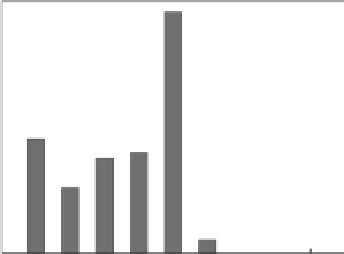Hardware Reference
In-Depth Information
2500
Category: medium jobs
(up to 16K procs)
31% of core-hours
2000
Category: small jobs
(up to 4K procs)
28.5% of core-hours
Category: large jobs
(up to 160K procs)
40.5% of core-hours
1500
1000
500
0
PARTITION SIZE
FIGURE 27.2: Histogram of the number of core hours consumed by Darshan-
instrumented jobs in each partition size on Intrepid. The histogram bins are
further categorized into small, medium, and large sizes for subsequent analysis.
data collected on the ALCF Intrepid Blue Gene/P system. Intrepid is a 557-
teraflop system containing 163,840 compute cores, 80 TB of RAM, and 7.6
PB of storage. More information about Intrepid and its I/O subsystem can be
found in Chapter 4. Darshan has been used to automatically instrument MPI
applications on Intrepid since January 2010. In this case study, five months
of Darshan log files are analyzed from January 1, 2013 to May 30, 2013.
Darshan instrumented 13,613 production jobs from 117 unique users over this
time period.
The jobs instrumented by Darshan in the first five months of 2013 ranged
in size from 1 process to 163,840 processes, offering an opportunity to ob-
serve how I/O behavior varies across application scales. Figure 27.2 shows a
histogram of the number of core hours consumed by Darshan-instrumented
jobs in each of the 9 available partition sizes on Intrepid. The most popular
partition size in terms of core-hour consumption contains 32,768 cores. The
jobs can be split into three comparably sized, broader categories for further
analysis; however, 28.5% of all core hours were in partitions of size 4,096 cores
or smaller, 31% of all core hours were in partitions of size 8,192 or 16,384, and
40.5% of all core hours were in partitions of size 32,768 or larger.
Figure 27.3 shows the total amount of data read and written by jobs in each
partition size category. All three categories are dominated by write activity
with one notable exception: the small job size category is dominated by a single
climate application labeled as \Climate user A." This application accounted
for a total of 776.5 TB of read activity and 31.1 TB of write over the course of
the study by reading as much as 4.8 TB of netCDF data in each job instance.
The other notable trend evident in Figure 27.3 is that smaller jobs accounted
for a larger fraction of the I/O usage on the system than larger jobs.
Figure 27.4 illustrates the prevalence of two key I/O characteristics across
job size categories. The first is file-per-process file usage. A job was defined

























